





In a warm, arid climate, many succulents and cacti actually need canopy protection. The following article discusses some of the best tree/shrub canopy choices for cactus and succulent gardens.
Here in the hot inland climate of southern California, the most important plant in a succulent garden might be one that provides some shade. Shade for succulents? Don't succulents want all the sun they can get? For the most part, that's true, and many species suffer when they sit in the shade all the time. But here in the valley, it frequently gets over 100 degrees F; all-day direct sun in the late spring through early fall can damage--if not kill--a lot of the succulents, and even cacti, that I grow. Without some overhead protection, I would not be able to grow but a fraction of the succulents I can now.
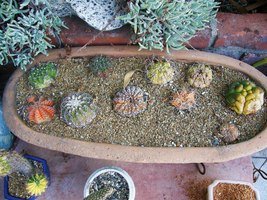
My sun-fried Gymnocalycium collection sure could have benefited from a shade tree.
Winter can also pose a problem when you grow marginal species in a climate such as mine. My garden is prone to frequent dips below freezing, and these can be as devastating, if not more so, than the heat and sun of summers. A well-placed evergreen tree or shrub can mean the difference of a few degrees, which can, in turn, mean the difference between life and death in the succulent garden. A canopy is a great mediator of temperature extremes, both highs and lows.
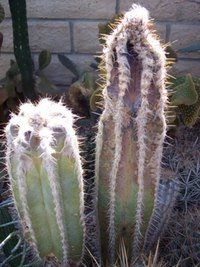 these Pilosocereus melted to death from freeze while others under canopy did OK
these Pilosocereus melted to death from freeze while others under canopy did OK
But trees in succulent gardens can have downsides, too. Is there a perfect tree? After growing succulents for about 15 years, I have decided there are a limited number of tree species that compliment cacti and succulents. And after trying to extract leaves from 'evil' spiny cacti and agaves, and repeatedly removing the rotted, over-shaded plants from my garden, I have discovered many of the canopy species that I have do NOT go well with succulents. For example, Magnolia trees and spiny succulent gardens don't mix, for a variety of reasons. Too much shade, too many leaves and seed pods falling all year round (I shed much blood weekly removing this litter), too extensive and competetive a root system, too little water for the tree or too much for the succulents, different soil needs, etc. And my Acacia baileyana, which provides the 'perfect' light shade for most succuelnts, is constantly dripping sap on everything, and then its bounty of itty bitty leaves adhere almost permanatly to all the plants below, making them nearly impossible to clean up; it's disgusting! So what trees are acceptable?
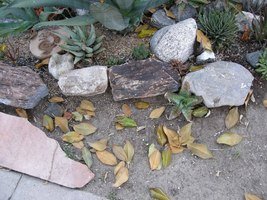

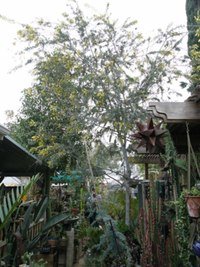
(left and middle) Magnolia leaves fall year-round and necessitate endless cleaning up, but in May the problem quadruples in severity--NOT a good tree for a succulent garden! (right) Acacia baileyana tree I planted in the succulent garden on purpose; what a messy tree!
When you visit some of the larger, more well-kept and planned public and private succulent gardens, some trees are obviously ‘working out', while others are not. The following article is a brief discussion of some of these trees that seem to work out well for succulent gardens in warm, arid climates. Very different species would probably be needed for succulent gardens in cooler, wetter climates.
Is there a perfect tree for such gardens? A perfect tree is not too large or too small; it provides a light, even canopy shade (a too-dense canopy rules out many potential trees) over a relatively wide area. The perfect tree does not drop many leaves and provides both summer and winter protection from the sun and cold; it is not too cold-sensitive for my climate and is drought- and heat- tolerant. Moreover, the perfect tree does not have overly-competitive roots, is easy to manage, and is not super rare or expensive. There is something that fits this description perfectly; it's called shade cloth. But as far as trees go, there just is no such thing as the perfect tree.
Those in the nursery trade know this and indeed solve this problem by erecting shade cloth or transparent roofing over their precious succulent collections. I have actually considered putting up shade cloth over my entire yard, but I am not sure my neighbors would appreciate it, nor would the city for that matter. And the costs and maintenance of such a huge structure have kept me from building one, despite the constant temptation to do so. I have a few small structures about the yard and the shade cloth only lasts a while before a squirrel or cat tears a hole in it. Leaves, along with bird, squirrel and cat droppings collect on them, necessitate constant cleaning. And trees certainly look more ‘natural' than a large wooden or metallic shade structure does.
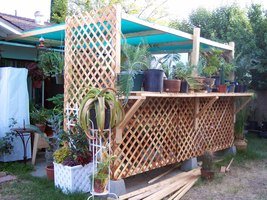
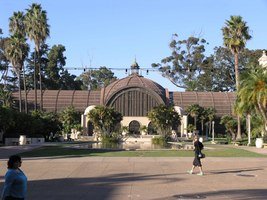
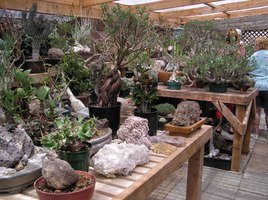
(left) My own shade structure for palms and succulents. (middle) Massive slatted structure in public garden protects the plants within. (right) An impeccable succulent collection in southern California protected by shade cloth and plastic sheeting.
As there does not appear to be a perfect tree, I have a few listed here that are acceptable; I do not have experience with all of them, but I have collected information from others who grow them.
Probably the best trees for growing alongside succulents and cacti are drought-tolerant palms. Palms tolerate the same soils and water needs of most succulents, have non-invasive or competing roots, and best of all, don't drop much, if any, litter. The down side of palms is that they don't create much shade either (though multiple palms can take care of that problem). Most of the really drought-tolerant species don't grow quickly, so the shade you need could be years down the road. Just a few species that are excellent for succulent gardens include Braheas (Brahea armata being the best), date palms, but these eventually get too tall to make much useable shade, and also eventually become heavy litter-droppers; Washingtonias, which also get too tall to do much good and can be real weed producers; triangle palms (Dypsis decaryi) and queen palms (but older palms create lots of seed). If you can provide extra water to the palms without rotting the succulents, Bismarckia, Hyphaenes, Livistonas and Sabals can make good choices as well.
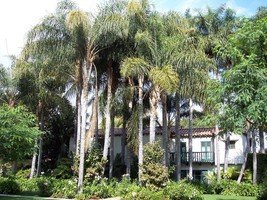
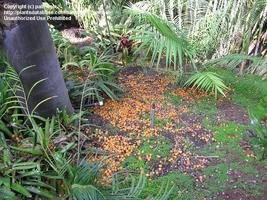
Queen palms are cheap, grow fast, make a nice light canopy, but can dump a lot of seeds if you fail to remove the flower spikes.

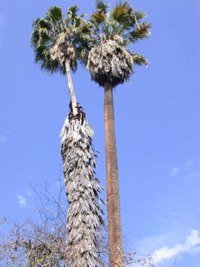
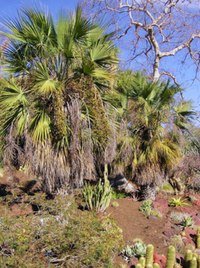
Washingtonias are a natural desert canopy species, but quickly grow too tall to be much use and are horribly dirty for palm trees. Note all the fallen leaves in last photo, not to mention the gazillions of seedlings that erupt yearly beneath these trees. First photo of palms in desert by Kelli
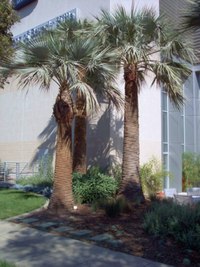
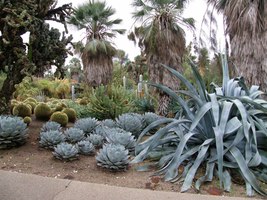

(left and middle) Brahea armata is a good choice for growing in a succulent garden. (right) Brahea aculeata, grows well in a succulent garden, but is not a big shade producer.
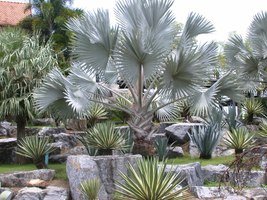
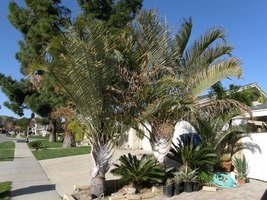
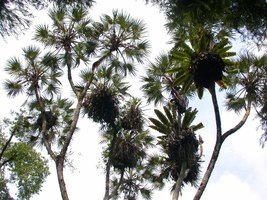
Bismarckias do well in succulent gardens once established, but are a bit thristy for some gardens; triangle palms (middle photo) make nice canopy and are very drought tolerant, and Hyphaenes make great canopy (but take dozens of years to get tall enough). All these are a bit on the cold sensitive side, too.
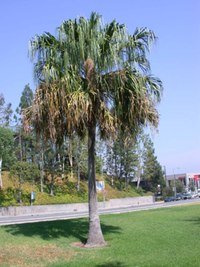
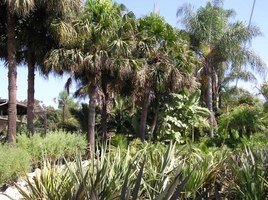
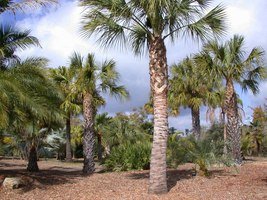
Livistonas (first two photos) and Sabals also are decent canopy palms, and have excellent cold tolerance, but they like more water than most succulents.
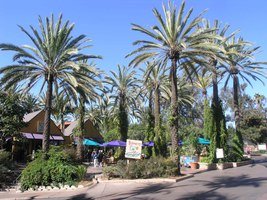
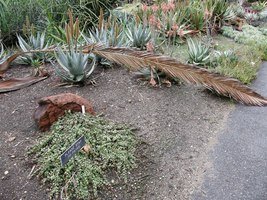
Date palms work well in succulent gardens; date production can be a problem (lots of non-viable seed) and some leaf litter, although most leaves fall slowly and do minimal damage.
But if you are looking for some trees with more shade potential, you can try one of the following. Just remember that with all these trees, leaf litter can be an issue.
Acacia xanthophloea (Fever Tree) and other African Acacias. This is not a tree I have grown but I have seen it in several public succulent gardens and it indeed seems a pretty good choice, being relatively clean (at least compared the Australian Acacias I have grown) with a light canopy (sometimes a bit useless) that starts above head level (conveniently), dinky leaves, a wonderfully colorful trunk and a spreading shape. It is spiny, but most of the succulents and cactus I grow are at least as spiny. Other spiny African Acacias may be similarly good choices, though most are a tad on the cold sensitive side and would be prone to be wiped out in my climate every 10 to 20 years. This could be the best choice on the list.
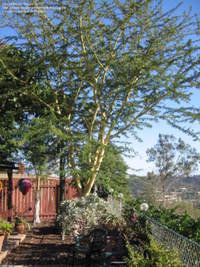 Acacia xanthrophloea (photo by chgrpt)
Acacia xanthrophloea (photo by chgrpt)
Albizia julibrissin 'Summer Chocolate' (Chocolate Mimosa, Chocolate Persian Silk Tree). Suggesting this tree seems insane, as the last tree I would want to plant over my succulent garden would be a regular Mimosa tree. A search of discussions on the internet concerning this cultivar concludes this tree is basically no different other than the color (leaves of deep maroon-brown). However, I have yet to see a photo of this as a large tree. Descriptions of it say it is a fast-growing tree, so why are there no massive chocolate canopies on the internet? Perhaps it is such a new cultivar that those just haven't occurred yet. But so far this tree in my yard has been a fairly good canopy tree for my succulent garden, albeit a relatively dirty one, and will probably only get worse with time, I'm afraid. It has an excellent canopy shape (horizontal), only produces a light shade (so far) and of course is a wonderfully unique color. I'm not sure if this will be a good choice or a huge mistake. Mimosa trees shed their foliar bounty in 2 or 3 weeks, creating a mulching nightmare right as the rainy season starts-- totally the wrong time of year to have mulch. I will keep you all posted.
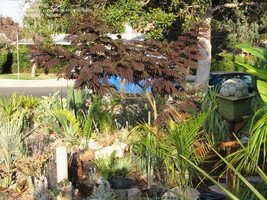
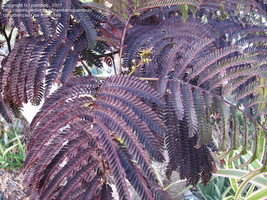
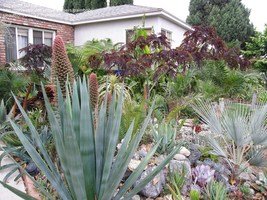
Shots of my Albizia julibrissin 'Chocolate' shading the succulents below (still a seedling now so not too much of a mess.... yet)
Aloe barberae (Tree Aloe). Aside from being cold-sensitive (leaf damage occurs at just a few degrees below freezing), this is one of the most perfect of all the canopy trees for succulent gardens. The leaf drop is minimal, and easy to extract from cacti, and it is extremely drought-tolerant. Canopy shade is rarely stifling, though it can take a few years to become significant at all. But it is a magnificent tree and has most of the other characteristics of the perfect canopy tree for succulents and cacti.
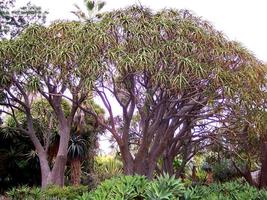
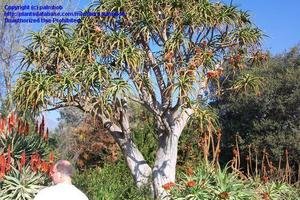 Aloe barberaes in public/ private gardens
Aloe barberaes in public/ private gardens
Araucaria bidwillii (Bunya Bunya). I don't know how seriously I would consider this a good succulent garden tree since it is a tad on the thirsty side, but older trees probably have enough drought tolerance to be a decent choice. Leaf drop is minimal and the canopy is constant (though stifling if not trimmed back); low water situations can keep the canopy sparse. I see conifers in many succulent gardens, but most produce either too much needle drop and/or too much shade. However, this is closer to ideal than most.
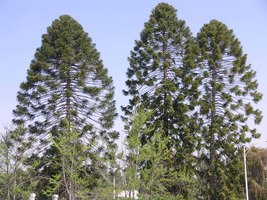
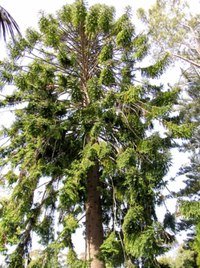
Araucaria bidwilli photos showing why this is a great canopy tree as well as a good landscaping specimen all around
Beaucarnea species (Bottle 'Palms'). I use these species in my own gardens as canopy structures and they have many advantages over most 'normal' trees on this list, the main one being no leaf drop at all. They are unsurpassed in their drought tolerance, look great, have high wind- and heat- tolerance, have non-competitive roots, and are among the lowest maintenance 'trees'. Their downside is their massive and ever-expanding base that slowly starts to crowd out anything within the shade production canopy, which can be too dense and not quite horizontal enough to make the 'perfect' list.
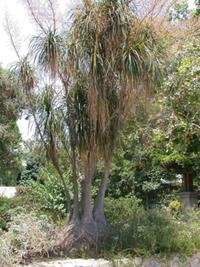
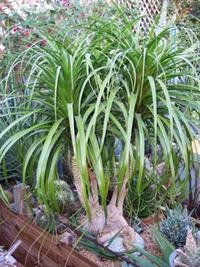
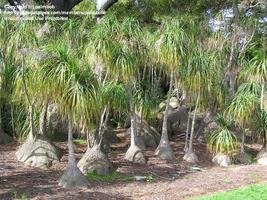
(left) Large Beaucarneas make fairly effective canopies. (middle) My own Beaucarnea guatemalensis acting as a protective canopy for delicate succulents planted around its base. (right) A garden full of Beaucarneas can create the perfect canopy shade.
Casuarina species (She-oaks). This was a suggestion on the tree discussion group, as She-oaks are very drought-tolerant and have relatively sparse canopy shade. The shade is nice and filtered because these trees have needles instead of leaves (they look like wispy conifers), but they are better adapted to hot, dry climates than are most pine trees. Are they messy? Can't say for sure but a perusal of the litter below these trees at local botanical gardens does not suggest serious litter accumulation. However these are known in the literature for improving soil richness thanks to their leaf fall (that doesn't sound good). The litter is at least spread out year round (no leaf-drop season) and the shape of the leaves suggests they would not produce a dense, water-retaining mess. But I could be wrong.
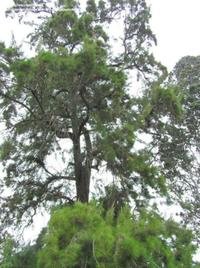

(left) A She-oak, this Allocasuarina torulosa produces a nice, filtered shade. (right) Casuarina cunninghamia also makes a nice, delicate shade.
Chilopsis linearis (Desert Willow). Though I have not grown this tree, my visits to botanical gardens where these are growing, and information I have read, suggests to me this could be as close to the ‘perfect' non-palm tree I will find for growing as a canopy tree in a succulent garden. These are remarkably drought-tolerant, thrive in hot climates, have thin, waxy leaves that do tend to create a thick, water-trapping leaf drop, have a relatively sparse canopy, and have gorgeous blooms part of the year to boot. The main problem with this tree is its deciduous habit, and there is a period when the leaves suddenly cover the plants below, necessitating clean up. And it is not a very cold-hardy tree, showing damage at temperatures just a bit below freezing (thankfully it's usually leafless then anyway).
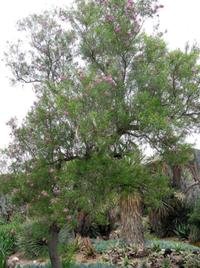
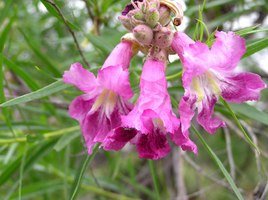
Chilopsis linearis growing in Huntington gardenss as a canopy tree for succulents; flowers of this beautiful tree
Chorisia insignis or speciosa (Floss Silk Trees). I have seen and used these trees as canopy trees for several reasons. One is they are wonderful looking trees with fantastically weird green, fat trunks covered with barnacle-looking spines, and have a fantastic flowering episode in the fall. They are also very drought-tolerant and very hard to kill in my warm Mediterranean climate. If judiciously pruned, the canopy is excellent for succulents, not being too dense, but spreading and providing nice summer sun protection. However, they have several massive biomass drops, first with the flowers, and later the leaves. And both flowers and leaves are the moisture-trapping variety that can lead to the rotting of sensitive, sun-needy succulents and cacti below.
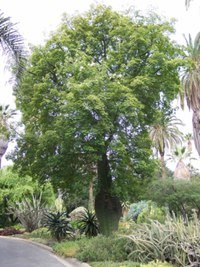
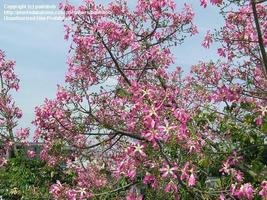
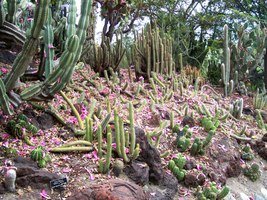
(left) Chorisia insignis as a shade tree in Huntington Gardens. (middle) Chorisia speciosa crown showing beautiful flowers. (right) Flowers all over the cactus at the Huntington, creating a beautiful but potentially hazardous (rot-forming) mess
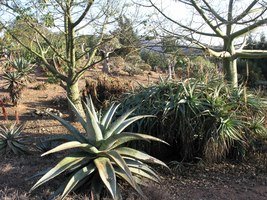
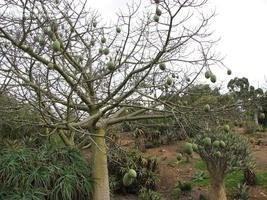
two shots of same succulent garden showing leafless Chorisia speciosas in winter
Cussonia panniculata is a relatively uncommon species of ‘cabbage tree' with pale blue, lacerate leaves and a relatively small but drought-hardy root system. Though this tree does drop its leaves, it doesn't have a season drop, and it drops little else. However, it is slow-growing and most do not grow a large crown for decades, so shade production is minimal. And when shade does come, it can be total unless the tree is pruned thoroughly. This is a somewhat touchy and slow-growing plant, another strike against it.
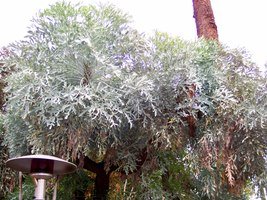
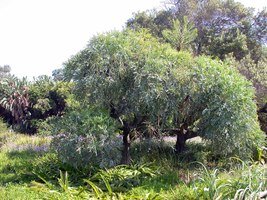
Cussonia panniculata growing in two different botanical gardens in southern California
Dracaena draco (Dragon Tree). Though the canopy of this beast can be oppressive if not trimmed back, this is another 'close-to-perfect' plant with minimal leaf drop and all the other things that make a perfect canopy tree perfect. It takes a long time to grow large enough to have canopy, however; you must either pay upfront for a large specimen, or be patient. This tree does have a tendency to drop limbs now and then which can be terribly damaging to the senstive plants below, but prudent trimming can minimize the risk.
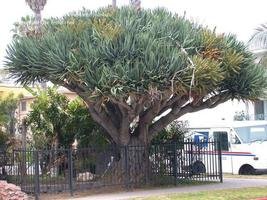
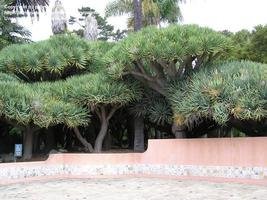
Dracaena draco photos showing the potential canopy effect, though it takes decades to grow a canopy anywhere near this large
Erythrina acanthocarpa (Tambookie Thorn). I have seen various Coral tree species used as canopy in succulent gardens but most (in my estimation) are too messy, despite being drought-tolerant and highly ornamental. But this shrub is one of the better choices for producing a light shade during the hottest times of the year, and producing the most magnificent flowers of all the Erythrina. However it is a small, slow-growing shrub with a sparse canopy, and it is not an attractive plant during much of the year when leafless and flowerless. On top of that, it is an exceedingly difficult plant to find in cultivation.
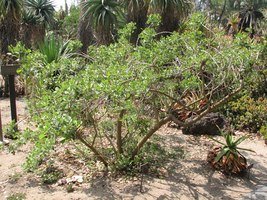
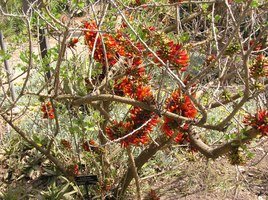
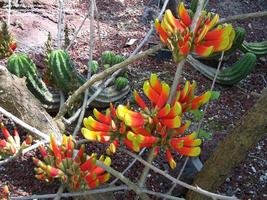
(left) Erythrina acanthcarpa in early summer. (middle and right) Flowering in early spring in a succulent garden at the Huntington Gardens.
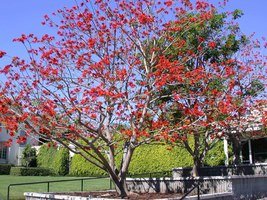
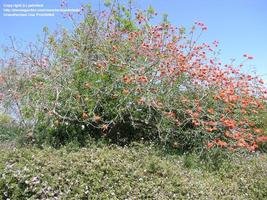
Other Erythrina species are drought tolerant and make good shade as well as having amazingly ornamental flowers... but these trees are very dirty
Euphorbia cotinifolia (Mexican Red Spurge). This was a suggestion and I do not have personal experience with this species. It is a bit on the tender side, but then so are a lot of my succulents. It certainly has a canopy that is not too dense, but it is not too spreading, either, and might be a decent choice for relatively small areas of a succulent garden one needs some summer shade. The color is similar to the Smoke tree and is quite striking in a garden of greenery. It is a deciduous plant and though it is drought-tolerant, it does tend to dump all its leaves if it dries out too much. Euphorbia lambii is another similar choice in terms of size, canopy and leaf loss, though it is not nearly as impressive a small tree or large shrub.
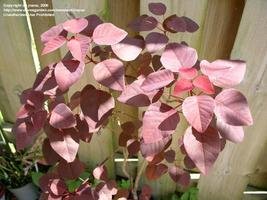
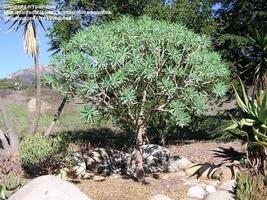
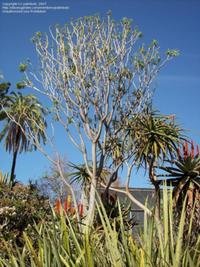
Euphorbia cotinifolia (photo by jnana) first photo; second two photos are of Euphorbia lambii, first in full leaf, and second just starting to rel-eaf in spring
Ficus palmeri and F. petiolaris (Rock Figs). Both of these plants are particularly drought-tolerant for Ficus species and are not massive fruit producers (fig droppings can be hard on succulent gardens.) They stay small and have a slow, steady evergreen leaf drop. If not trimmed some, they can produce and overwhelming shade, but that is usually only a problem in older plants. However, neither is very fast growing and can take a while for canopies to form. Other Ficus species may work as canopy trees as well, though they usually require constant pruning to keep the shade from getting too dense, and some are thirsty species.
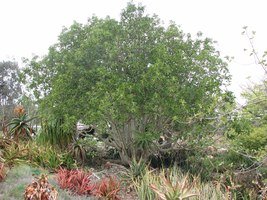
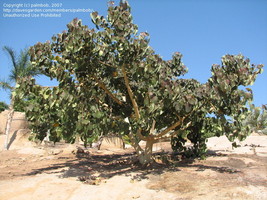
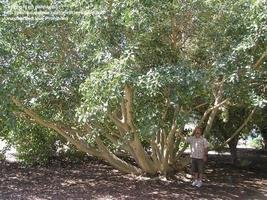
(left) Ficus palmeri in succulent garden being used as a canopy tree. (middle and right) Maturing and very old Ficus petiolaris in southern California.
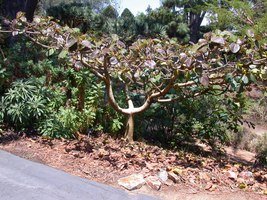
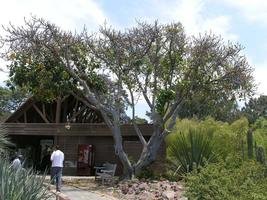
Ficus socotrana and Ficus lutea both make decent canopy species.
Manihot grahamii (Hardy Tapioca). Of all the non-palms I have personally grown, this is one of my favorite trees for growing in succulent gardens. It has a perfect canopy: sparse but effective, and it is very hardy in terms of heat and drought. It is a relatively small tree, though growing quickly to a height that provides some canopy protection in just a few years from a dinky seedling. The leaves are a wonderfully ornamental shape (highly lacerate) and curious and dry up to nearly weightless carcasses before falling to the ground in late fall. But it still is a deciduous tree and offers no winter protection. Additionally it is a tad on the invasive side, tending to pop up seedlings everywhere (but easy to weed out) in my climate.
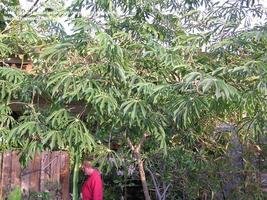
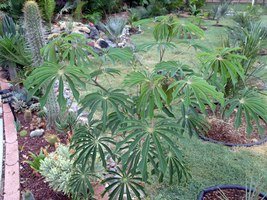
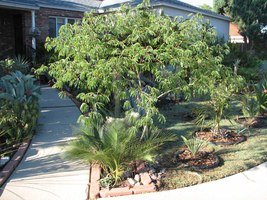
Manihot grahmii trees, showing ornamental leaf shape and nice canopy shape as well
Parkinsonia microphylla (Small-leaved or Foothill Palo Verde) and other Parkinsonias. In my estimation, a pretty good tree for growing in a succulent garden. It has about the perfect amount of shade, itty bitty foliage, is extremely drought- and heat- tolerant, and has an attractive green trunk and stem color. My main complaint with this tree is it tends to be leafless at the hottest time of the year-- late summer and early fall--when the plants below could use the canopy the most. It also does not offer much, if any, winter cold protection. But its leaves aren't large enough to create a mulching overload problem.
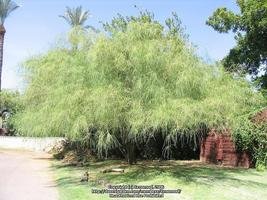
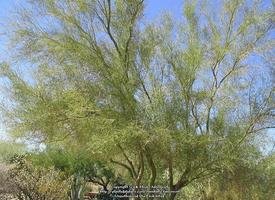
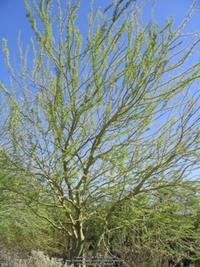
(left-right) Three different Parkinsonia species photographed in Arizona by Xenomorf: Parkinsonia microphylla, Parkinsonia aculeata and Parkinsonia praecox.
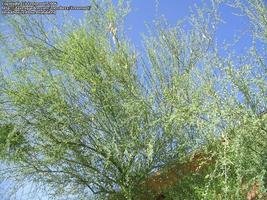
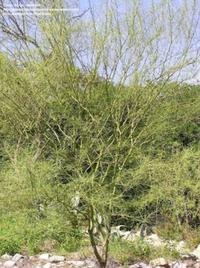
Parkinsonia florida in Arizona (photo by Xenomorph) and Parkinsonia aculeata in California (my photo)
Prosopis species (Mesquites). I have a Chilean Mesquite (Prosopis chilensis) and though it makes a perfect canopy shade, it is a very dirty tree. However, the dirtiness is manageable since the leaves are so dinky. It is very drought- and heat- tolerant. It is deciduous so leaf drop in fall is a problem. And it has massive roots that can out-compete the succulents so much there could be a problem with not enough water for them in summer. It also has a tendency to get huge, so would not be a good choice for my yard; I am going to get rid of mine before it gets too large, I guess.
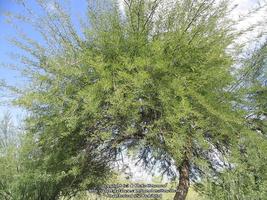
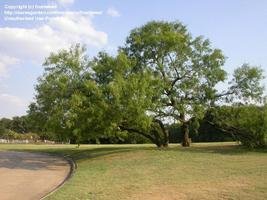
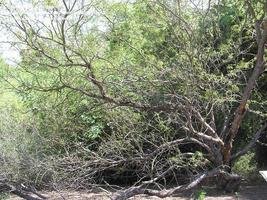
(left) Prosopis chilensis (photo by Xenomorf). (middle) Prosopis juliflora (photo by Frostweed). (right) Prosopis glandulosa
Thevetia peruviana and T. thevetioides (Mexican Oleander). I think these are among the better choices for succulent gardens in my climate, as they are well adapted to heat, drought and full sun. And they are evergreens with minimal leaf drop. The leaves are thin and do not tend to collect a lot of moisture below them. However the canopy can become pretty dense, so regular pruning is necessary, which can be a problem if you are sensitive to its highly toxic, irritating saps. These are beautiful trees, with great bright yellow flowers. These are rapidly becoming some of the more popular public landscaping trees here in Los Angeles. I have not grown them, but I have seen in well managed succulent gardens and it is a pretty good choice as non-palms go.
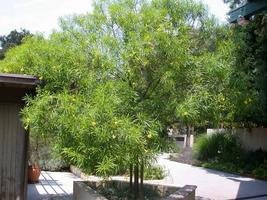
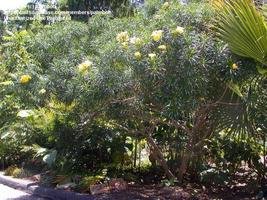 Thevetia peruviana and thevetioides
Thevetia peruviana and thevetioides
Bottom line: there is no perfect tree for the average warm-climate cactus and succulent garden, but these are a few suggestions to consider. You may have more suggestions, so please feel free to add them to the comments below.
Copyright © www.100flowers.win Botanic Garden All Rights Reserved